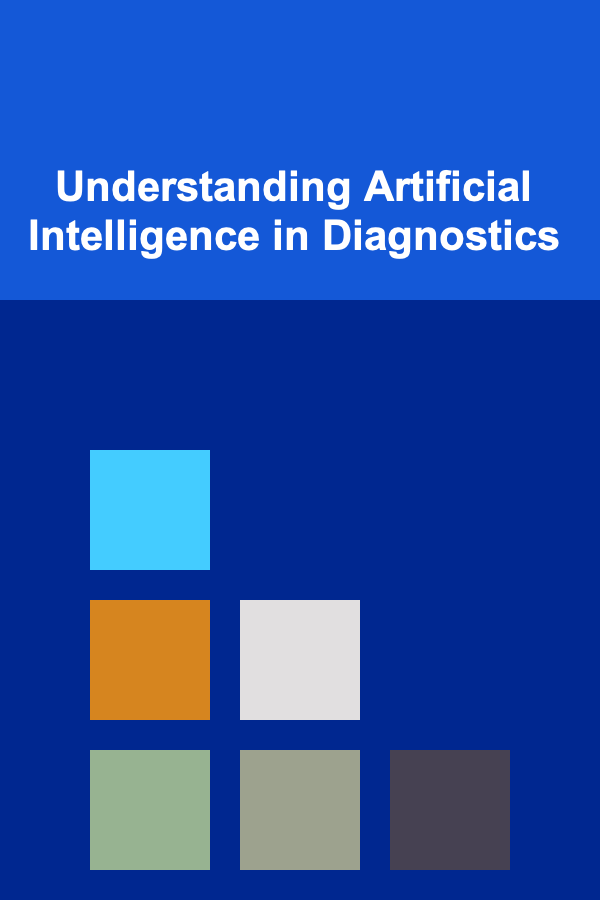
Understanding Artificial Intelligence in Diagnostics
ebook include PDF & Audio bundle (Micro Guide)
$12.99$5.99
Limited Time Offer! Order within the next:

Introduction: The Diagnostic Revolution
Artificial intelligence (AI) is rapidly transforming numerous industries, and healthcare, particularly diagnostics, is at the forefront of this revolution. From identifying cancerous lesions in medical images to predicting patient risk for specific diseases, AI-powered diagnostic tools are showing immense promise in improving accuracy, efficiency, and accessibility of healthcare. However, understanding how AI works in diagnostics and appreciating its capabilities and limitations requires a multi-faceted approach. This article delves into the fundamental concepts of AI in diagnostics, explores its various applications, discusses the challenges and ethical considerations, and offers insights into the future of this rapidly evolving field.
The term "diagnostics" encompasses a broad range of procedures and technologies used to identify diseases, conditions, and abnormalities within the human body. Traditional diagnostics relies heavily on clinical expertise, laboratory tests, imaging modalities (like X-rays, CT scans, and MRIs), and patient history. AI enters this landscape as a powerful tool to augment and enhance these existing methods, rather than replace them entirely. By leveraging vast amounts of data and sophisticated algorithms, AI can uncover subtle patterns and insights that might be missed by human clinicians alone, leading to earlier and more accurate diagnoses.
Fundamentals of AI in Diagnostics: Key Concepts
At its core, AI in diagnostics involves using computer systems to perform tasks that typically require human intelligence, such as pattern recognition, reasoning, and decision-making. Several key concepts are crucial to understanding how AI is applied in this context:
1. Machine Learning (ML): The Engine of AI
Machine learning is a subset of AI that focuses on enabling computer systems to learn from data without being explicitly programmed. Instead of relying on pre-defined rules, ML algorithms learn patterns and relationships directly from the data they are trained on. This allows them to make predictions or decisions about new, unseen data.
Several types of ML are commonly used in diagnostics:
- Supervised Learning: The algorithm is trained on a labeled dataset, where each data point is associated with a known outcome or diagnosis. The algorithm learns to map input features (e.g., image pixels, lab results) to output labels (e.g., presence or absence of a disease). Examples include classification (predicting a category) and regression (predicting a continuous value).
- Unsupervised Learning: The algorithm is trained on an unlabeled dataset, where the outcomes are unknown. The algorithm aims to discover hidden patterns and structures within the data, such as clustering similar patient groups or identifying anomalies.
- Reinforcement Learning: The algorithm learns through trial and error, receiving rewards or penalties based on its actions. While less common in diagnostics compared to supervised learning, reinforcement learning can be used for optimizing treatment plans or developing diagnostic strategies.
2. Deep Learning (DL): A Powerful Subset of ML
Deep learning is a specialized form of machine learning that uses artificial neural networks with multiple layers (hence "deep"). These deep neural networks can automatically learn complex features from raw data, such as images, text, or audio, without requiring manual feature engineering. This makes deep learning particularly well-suited for tasks like image analysis, natural language processing, and signal processing.
Convolutional Neural Networks (CNNs) are a specific type of deep neural network widely used in medical image analysis. CNNs are designed to automatically learn spatial hierarchies of features from images, making them highly effective for tasks like detecting tumors in radiology scans.
3. Natural Language Processing (NLP): Understanding Clinical Text
Natural language processing is a field of AI that focuses on enabling computers to understand and process human language. In diagnostics, NLP can be used to extract information from unstructured clinical text, such as patient notes, medical reports, and research articles. This information can then be used to improve diagnosis, treatment planning, and clinical decision support.
Examples of NLP applications in diagnostics include:
- Identifying relevant information from patient records: NLP can automatically extract key symptoms, medical history, and risk factors from patient notes, saving clinicians time and effort.
- Analyzing medical literature: NLP can be used to identify relevant research articles and extract key findings related to specific diseases or treatments.
- Developing chatbots for patient triage: NLP-powered chatbots can interact with patients to gather information about their symptoms and direct them to the appropriate level of care.
4. Explainable AI (XAI): Understanding AI Decisions
As AI models become more complex, it becomes increasingly important to understand how they arrive at their decisions. Explainable AI (XAI) is a field of AI that focuses on developing methods to make AI models more transparent and interpretable. In diagnostics, XAI can help clinicians understand why an AI model made a particular diagnosis, which can increase trust and confidence in the technology.
Several techniques are used to improve the explainability of AI models:
- Feature importance analysis: Identifying the features that had the greatest influence on the model's decision.
- Saliency maps: Highlighting the regions of an image that were most important for the model's classification.
- Decision rule extraction: Extracting a set of human-readable rules that approximate the behavior of the AI model.
Applications of AI in Diagnostics: Transforming Healthcare
AI is being applied to a wide range of diagnostic tasks across various medical specialties. Here are some prominent examples:
1. Medical Imaging Analysis
Medical imaging is one of the most promising areas for AI in diagnostics. AI algorithms can analyze X-rays, CT scans, MRIs, and other medical images to detect and characterize diseases with high accuracy and speed.
- Radiology: AI can assist radiologists in detecting lung nodules, breast cancer, brain tumors, and other abnormalities in medical images. AI algorithms can also quantify the size and shape of lesions, track their growth over time, and differentiate between benign and malignant tumors.
- Pathology: AI can analyze microscopic images of tissue samples to identify cancerous cells, assess the grade and stage of tumors, and predict patient response to treatment. AI algorithms can also automate tasks like cell counting and immunostaining analysis, improving efficiency and reproducibility.
- Ophthalmology: AI can analyze retinal images to detect diabetic retinopathy, glaucoma, and macular degeneration. AI algorithms can also measure the thickness of the retinal nerve fiber layer and identify signs of optic nerve damage.
2. Genomics and Precision Medicine
AI is playing an increasingly important role in genomics and precision medicine. AI algorithms can analyze large genomic datasets to identify genetic mutations that are associated with specific diseases, predict patient risk for developing certain conditions, and personalize treatment plans based on an individual's genetic profile.
- Disease risk prediction: AI can analyze an individual's genome to estimate their risk of developing diseases like cancer, heart disease, and Alzheimer's disease.
- Drug response prediction: AI can predict how a patient will respond to a particular drug based on their genetic makeup.
- Personalized cancer therapy: AI can identify genetic mutations in cancer cells that can be targeted by specific drugs.
3. Laboratory Medicine
AI can improve the accuracy, efficiency, and automation of laboratory tests. AI algorithms can analyze blood samples, urine samples, and other biological specimens to detect diseases, monitor patient health, and guide treatment decisions.
- Automated cell counting: AI can automate the process of counting different types of cells in blood samples, improving accuracy and reducing the need for manual review.
- Analysis of flow cytometry data: AI can analyze complex flow cytometry data to identify different cell populations and detect abnormalities.
- Detection of infectious diseases: AI can analyze laboratory data to detect the presence of bacteria, viruses, and other pathogens.
4. Cardiology
AI is assisting in various aspects of cardiovascular diagnostics, from ECG interpretation to echocardiogram analysis.
- ECG Interpretation: AI algorithms can analyze electrocardiograms (ECGs) to detect arrhythmias, ischemia, and other heart conditions. AI can improve the speed and accuracy of ECG interpretation, particularly in emergency situations.
- Echocardiogram Analysis: AI can analyze echocardiograms to assess the structure and function of the heart. AI can automate measurements of heart chamber size, wall thickness, and ejection fraction, providing objective and reproducible assessments.
- Prediction of Cardiac Events: AI can use patient data, including medical history, lab results, and imaging studies, to predict the risk of future cardiac events, such as heart attacks and strokes.
5. Remote Patient Monitoring
AI is enabling remote patient monitoring by analyzing data collected from wearable sensors and other devices. This allows healthcare providers to track patient health remotely, detect early signs of deterioration, and intervene proactively.
- Wearable Sensors: AI can analyze data from wearable sensors, such as activity trackers and smartwatches, to monitor patient activity levels, sleep patterns, and vital signs.
- Remote Blood Pressure Monitoring: AI can analyze blood pressure readings collected remotely to detect hypertension and guide treatment decisions.
- Continuous Glucose Monitoring (CGM): AI can analyze CGM data to detect patterns and trends in blood glucose levels, helping patients with diabetes manage their condition more effectively.
Challenges and Limitations of AI in Diagnostics
Despite its immense potential, the implementation of AI in diagnostics faces several significant challenges and limitations:
1. Data Availability and Quality
AI algorithms require large amounts of high-quality data to be trained effectively. In many cases, sufficient data may not be available, particularly for rare diseases or specific patient populations. Furthermore, data quality can be a major issue, as medical data is often incomplete, inconsistent, and biased. Data bias can lead to AI models that perform poorly on certain patient groups or perpetuate existing health disparities.
2. Algorithmic Bias and Fairness
AI algorithms can inherit biases from the data they are trained on, leading to unfair or discriminatory outcomes. For example, if an AI model is trained primarily on data from one racial group, it may perform less accurately on patients from other racial groups. It is crucial to carefully address algorithmic bias and ensure that AI diagnostic tools are fair and equitable for all patients.
3. Generalizability and Robustness
AI models that perform well on one dataset may not generalize well to other datasets or clinical settings. This is because AI models can be sensitive to variations in data acquisition, processing, and patient populations. It is important to rigorously validate AI models on diverse datasets and ensure that they are robust to real-world variations.
4. Lack of Explainability and Transparency
Many AI models, particularly deep learning models, are "black boxes," meaning that it is difficult to understand how they arrive at their decisions. This lack of explainability can make it challenging for clinicians to trust and use AI diagnostic tools, particularly in high-stakes situations. Explainable AI (XAI) is an active area of research aimed at making AI models more transparent and interpretable.
5. Regulatory and Ethical Considerations
The use of AI in diagnostics raises several important regulatory and ethical considerations. Who is responsible when an AI diagnostic tool makes an error? How should patient data be protected and used responsibly? How can we ensure that AI is used to improve healthcare for all, rather than exacerbate existing inequalities? These are complex questions that require careful consideration and collaboration between stakeholders, including clinicians, patients, regulators, and AI developers.
6. Integration into Clinical Workflows
Successfully integrating AI into clinical workflows requires careful planning and execution. AI tools must be user-friendly, seamlessly integrate with existing systems, and provide clear and actionable insights. Clinicians need adequate training and support to effectively use AI tools and interpret their results. Resistance to change and concerns about job displacement can also hinder the adoption of AI in clinical practice.
Ethical Considerations: Navigating the Moral Landscape
The application of AI in diagnostics raises profound ethical considerations that must be carefully addressed to ensure responsible and equitable use of this powerful technology.
1. Patient Privacy and Data Security
AI algorithms rely on vast amounts of patient data, making patient privacy and data security paramount. Robust data protection measures are essential to prevent unauthorized access, breaches, and misuse of sensitive medical information. Compliance with regulations like HIPAA and GDPR is crucial, and ongoing vigilance is needed to stay ahead of evolving cybersecurity threats.
2. Algorithmic Bias and Fairness
As mentioned earlier, algorithmic bias can lead to unfair or discriminatory outcomes. It is crucial to proactively identify and mitigate bias in AI models to ensure that they are equitable and do not perpetuate health disparities. This requires careful data collection and preprocessing, rigorous model evaluation across diverse patient populations, and ongoing monitoring for bias in real-world performance.
3. Transparency and Explainability
The lack of transparency in many AI models can erode trust and hinder clinical adoption. Explainable AI (XAI) techniques are essential to provide clinicians with insights into how AI models arrive at their decisions, allowing them to understand and validate the results. Transparency also allows for accountability and facilitates the identification and correction of errors or biases.
4. Responsibility and Accountability
When an AI diagnostic tool makes an error, determining responsibility and accountability can be complex. Who is liable -- the AI developer, the clinician using the tool, or the healthcare institution? Clear guidelines and legal frameworks are needed to address these issues and ensure that patients are protected in the event of AI-related errors.
5. Informed Consent and Patient Autonomy
Patients should be informed about the use of AI in their diagnosis and treatment, and they should have the right to consent to or decline the use of these technologies. Patients should also have access to clear and understandable explanations of how AI is being used and what the potential benefits and risks are.
6. Impact on the Clinician-Patient Relationship
The introduction of AI into diagnostics has the potential to alter the clinician-patient relationship. It is important to ensure that AI tools are used to augment, rather than replace, the human element of healthcare. Clinicians should maintain their role as trusted advisors and advocates for their patients, using AI as a tool to enhance their clinical judgment and decision-making.
The Future of AI in Diagnostics: A Glimpse into Tomorrow
The field of AI in diagnostics is rapidly evolving, and the future holds immense promise for further advancements and transformative changes in healthcare.
1. Enhanced Diagnostic Accuracy and Speed
AI is expected to continue to improve the accuracy and speed of diagnosis, leading to earlier detection of diseases and more timely interventions. AI algorithms will become more sophisticated in their ability to analyze complex data, identify subtle patterns, and personalize diagnostic approaches.
2. Personalized and Predictive Medicine
AI will play an increasingly important role in personalized and predictive medicine. AI algorithms will be used to analyze individual patient data, including genomics, imaging, and clinical history, to predict the risk of developing certain diseases and personalize treatment plans based on individual needs.
3. AI-Powered Drug Discovery and Development
AI is accelerating the process of drug discovery and development by identifying potential drug candidates, predicting their efficacy and safety, and optimizing clinical trial design. This will lead to the development of new and more effective treatments for a wide range of diseases.
4. AI-Driven Healthcare Automation
AI is automating many routine tasks in healthcare, freeing up clinicians to focus on more complex and demanding aspects of patient care. AI-powered chatbots are providing patients with information, scheduling appointments, and triaging medical concerns. AI algorithms are automating tasks like medical coding and billing, reducing administrative burden and improving efficiency.
5. Democratization of Healthcare Access
AI has the potential to democratize healthcare access by making diagnostic tools and expertise available in remote and underserved areas. AI-powered mobile apps can provide patients with basic diagnostic services and connect them with remote clinicians for consultations. This will help to address health disparities and improve access to care for all.
6. Integration with Other Technologies
AI is being integrated with other emerging technologies, such as robotics, virtual reality, and augmented reality, to create new and innovative diagnostic and treatment solutions. Robotic surgery systems are being enhanced with AI to improve precision and control. Virtual reality is being used to train clinicians and provide patients with immersive and engaging healthcare experiences.
In conclusion, understanding artificial intelligence in diagnostics requires a grasp of fundamental AI/ML principles, awareness of its varied applications across medical domains, a realistic assessment of its limitations and ethical implications, and a vision for its transformative potential in the future of healthcare. As AI continues to evolve, continuous learning and critical evaluation will be crucial for healthcare professionals, policymakers, and the public alike to harness its benefits responsibly and equitably.

How to Add a Home Gym to Your Renovation Plans
Read More
How to Create a Relaxation Space That's Tidy and Inviting
Read More
How to Make Money Producing Music from Home: A Beginner's Guide
Read More
How to Set Up a Toy Rotation System for Kids
Read More
How to Use Vertical Storage to Maximize Small Rooms
Read More
How to Implement Bio-Inspired Design Principles
Read MoreOther Products

How to Add a Home Gym to Your Renovation Plans
Read More
How to Create a Relaxation Space That's Tidy and Inviting
Read More
How to Make Money Producing Music from Home: A Beginner's Guide
Read More
How to Set Up a Toy Rotation System for Kids
Read More
How to Use Vertical Storage to Maximize Small Rooms
Read More